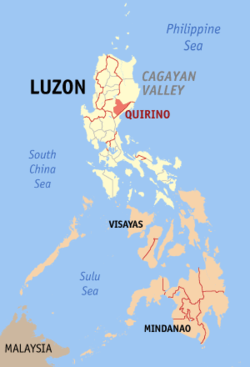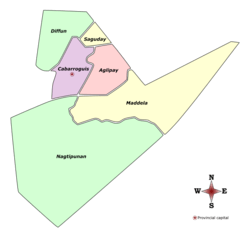Quirino
| Quirino | |||
|---|---|---|---|
| Province | |||
|
Quirino Provincial Capitol | |||
| |||
| Nickname(s): Forest Heartland of Cagayan Valley | |||
 Location within the Philippines | |||
| Coordinates: 16°17′N 121°35′E / 16.28°N 121.58°ECoordinates: 16°17′N 121°35′E / 16.28°N 121.58°E | |||
| Country | Philippines | ||
| Region | Cagayan Valley (Region II) | ||
| Founded | June 18, 1966 | ||
| Capital | Cabarroguis | ||
| Government | |||
| • Type | Province of the Philippines | ||
| • Governor | Junie E. Cua (LP) | ||
| • Vice Governor | May G. Calaunan (LP) | ||
| Area[1] | |||
| • Total | 3,323.47 km2 (1,283.20 sq mi) | ||
| Area rank | 55th out of 81 | ||
| Population (2010)[2] | |||
| • Total | 176,786 | ||
| • Rank | 73rd out of 81 | ||
| • Density | 53/km2 (140/sq mi) | ||
| • Density rank | 72nd out of 81 | ||
| Divisions | |||
| • Independent cities | 0 | ||
| • Component cities | 0 | ||
| • Municipalities | 6 | ||
| • Barangays | 132 | ||
| • Districts | Lone district of Quirino | ||
| Time zone | PHT (UTC+8) | ||
| ZIP code | 3400 to 3405 | ||
| Dialing code | 78 | ||
| ISO 3166 code | PH-QUI | ||
| Spoken languages | Ilocano, Ifugao, Bungkalot, Pangasinan, Kankana-ey, Tagalog, English | ||
| Website |
www | ||
Quirino is a landlocked province in the Philippines located in the Cagayan Valley region in Luzon and named after Elpidio Quirino, the sixth President of the Philippines. Its capital is Cabarroguis.
The province borders Aurora to the southeast, Nueva Vizcaya to the west, and Isabela to the north. Quirino used to be part of the province of Nueva Vizcaya, until it was separated in 1966.
History
Long before its formal creation as an independent province, Quirino was the forest region of the province of Nueva Vizcaya, inhabited by tribal groups known as the Negritos. They roamed the hinterlands and built their huts at the heart of the jungle.
On June 18, 1966, Republic Act 4734 was enacted, constituting the municipalities of Diffun, Saguday, Aglipay, and Maddela (all of Nueva Vizcaya province) into a new sub-province to be known as "Quirino", named after the late Philippine president Elpidio Quirino.[3][4]
On June 21, 1969, Republic Act 5554 was enacted, amending RA 4734 and creating the municipality of Cabarroguis (now the provincial capital town), which was taken from portions of Diffun, Saguday, and Aglipay.[5][4]
Republic Act 6394, authored by former Congressman Leonardo B. Perez, was passed on September 10, 1971 further amending RA 5554 and separating the sub-province of Quirino from its mother province, Nueva Vizcaya, constituting it into a regular province. [6][4]
The province of Quirino was formally established on February 10, 1972 upon the assumption to office of the first elected provincial and municipal officials headed by Dionisio A. Sarandi as Provincial Governor.
On February 25, 1983, Batas Pambansa Blg. 345 was enacted, creating within Quirino the municipality of Nagtipunan, a division of the municipality of Maddela.[7]
Geography
Quirino lies in the southeastern portion of Cagayan Valley. It is situated within the upper portion of the Cagayan River basin and bounded by Isabela on the north, Aurora on the east and southeast, and Nueva Vizcaya on the west and southwest.
The Sierra Madre mountain range provides a natural barrier on the eastern and southern border of the province and the Mamparang Range on the western part. The province is generally mountainous, with about 80 percent of the total land area covered by mountains and highlands. A large portion of the province lies within the Quirino Protected Landscape.
Climate
The province has a mean annual temperature of 33.6 °C (92.5 °F). May is generally the warmest month and the wettest months are March to August, with the rest of the year being neither too dry nor too wet. Heavy, sustained rainfall occurs from September to November.
Administrative divisions
Quirino is subdivided into 6 municipalities, all encompassed by a lone legislative district.
|
 | ||||||||||||||||||||||||||||||||||||||||||||||||||||||||||||||||||||||||||||||||||
Barangays
The 6 municipalities of the province comprise a total of 132 barangays, with Gundaway (Poblacion) in Cabarroguis as the most populous in 2010, and Rang-ayan in Aglipay as the least.[9][8]
Demographics
| Population census of Quirino | ||
|---|---|---|
| Year | Pop. | ±% p.a. |
| 1990 | 114,132 | — |
| 1995 | 131,119 | +2.63% |
| 2000 | 148,575 | +2.72% |
| 2007 | 163,610 | +1.34% |
| 2010 | 176,786 | +2.86% |
| Source: National Statistics Office[2][10] | ||
The population of the province as of the year 2010 census of population was 176,786[2] with a density of roughly 76 persons per square kilometer of land. The major language is Ilocano, which is widely spoken in the lowlands by 71.46 percent of the total populace. Ifugao is predominant in the uplands. Other languages are Bungkalot, Pangasinan, Kankana-ey, Tagalog, and English.
Religion
Quirino is predominantly Roman Catholic with 70 percent adherence while Aglipayan serves as a significant minority religion. Some people still practice indigenous beliefs. Other Christians are also well represented.
Economy
Agriculture is the main industry in the province, with rice and corn as major crops. These supply the demand of neighboring provinces and the metropolis. Banana as well as banana chips are major products sold in Metro Manila and Pampanga. Small scale industries like furniture making, basketry, rattan craft, and dried flower production are prevalent.
References
- ↑ "List of Provinces". PSGC Interactive. Makati City, Philippines: National Statistical Coordination Board. Retrieved 19 December 2013.
- 1 2 3 "Total Population by Province, City, Municipality and Barangay: as of May 1, 2010" (PDF). 2010 Census of Population and Housing. National Statistics Office. Retrieved 19 December 2013.
- ↑ "Republic Act No. 4734 - An Act Creating the Subprovince of Quirino in the Province of Nueva Vizcaya". Chan Robles Virtual Law Library. Retrieved 13 January 2015.
- 1 2 3 "Brief History of Quirino". Province of Quirino (official website). Retrieved 13 January 2015.
- ↑ "Republic Act No. 5554 - An Act Amending Republic Act Numbered Four Thousand Seven Hundred And Thirty-four, Entitled, "An Act Creating the Subprovince of Quirino in the Province of Nueva Vizcaya," and for Other Similar Purposes". Chan Robles Virtual Law Library. Retrieved 13 January 2015.
- ↑ "Republic Act No. 6394: An Act to Separate the Subprovince of Quirino from the Province of Nueva Vizcaya and Constitute It into a Regular Province to be Known as the Province of Quirino". Chan Robles Virtual Law Library. Retrieved 13 January 2015.
- ↑ "Batas Pambansa Blg. 345 – An Act Creating the Municipality of Nagtipunan, in the Province of Quirino". LGU.ph. Retrieved 13 January 2015.
- 1 2 3 4 "Province: Quirino". PSGC Interactive. Makati City, Philippines: Philippine Statistics Authority - National Statistical Coordination Board. Retrieved 5 January 2016.
- 1 2 "Total Population by Province, City, Municipality and Barangay: as of May 1, 2010 (Cagayan Valley)" (PDF). 2010 Census of Population and Housing. National Statistics Office. Retrieved 5 January 2016.
- ↑ "Population and Annual Growth Rates for The Philippines and Its Regions, Provinces, and Highly Urbanized Cities" (PDF). 2010 Census and Housing Population. National Statistics Office. Retrieved 26 August 2013.
External links
| Wikimedia Commons has media related to Quirino (province). |
 Geographic data related to Quirino at OpenStreetMap
Geographic data related to Quirino at OpenStreetMap- Official Website of the Provincial Government of Quirino
- Philippine Standard Geographic Code
- Local Governance Performance Management System
 |
Isabela |  | ||
| Nueva Vizcaya | |
Aurora | ||
| ||||
| | ||||
| Aurora |
| ||||||||||||||
| ||||||||||||||||||||||||||||||||||
| |||||||||||||||||||||||||||||||||||||||||||||||||||||||||||||||||||||||||||||




